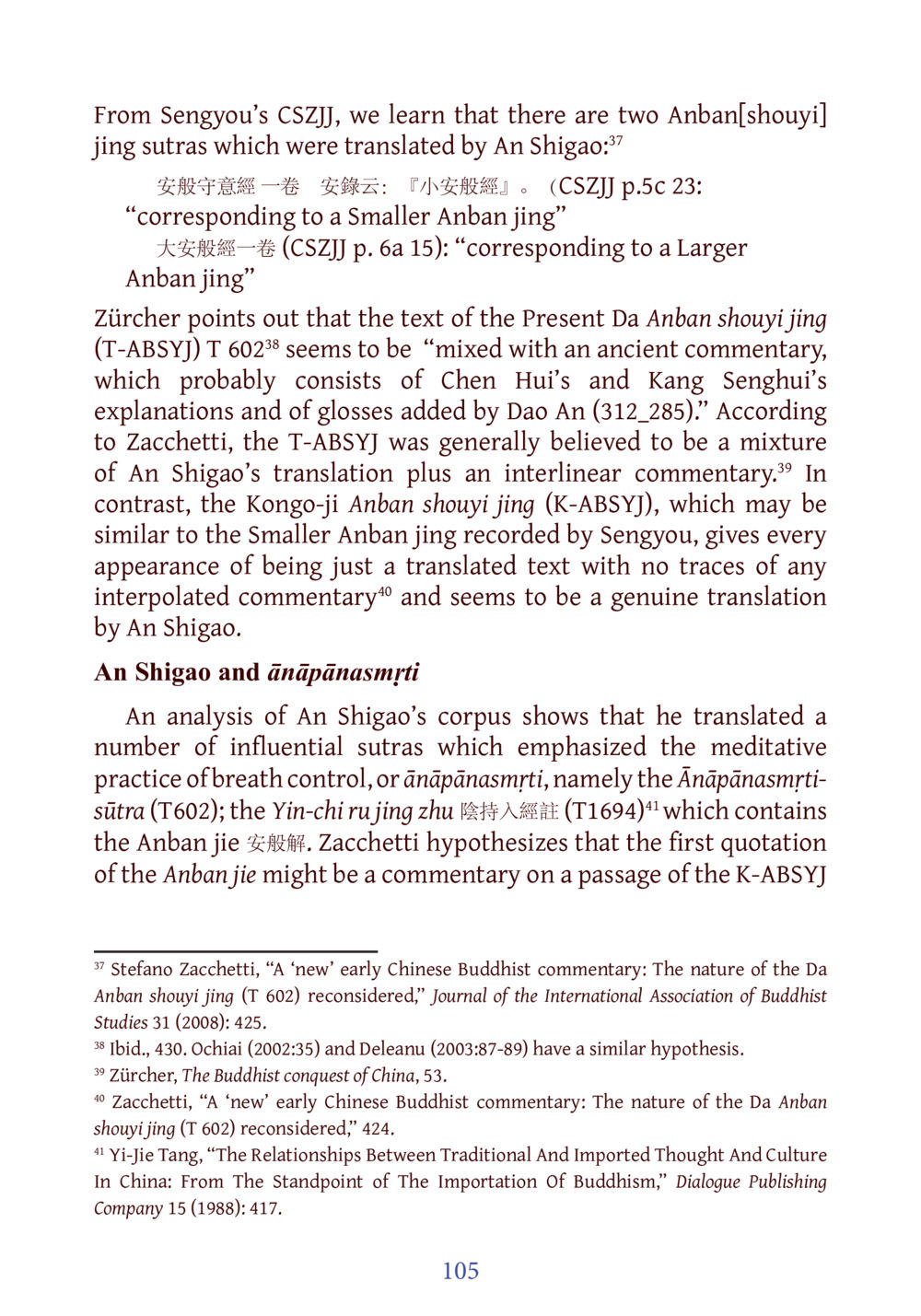An Shigao's Influence on Anban Sutras : หน้า 126/141
DIRI Journal : หน้า 126/141 Exploration of An Shigao's translations of Anban sutras and their impact on Buddhist practices of breath control.
11 ครั้ง

สรุปเนื้อหา
This content examines An Shigao's translations of Anban sutras, highlighting the distinctions between the Present Da Anban shouyi jing and the Kongo-ji Anban shouyi jing. The text discusses the integration of commentaries and the significance of breath control in Buddhist meditation practices. An Shigao’s contributions are vital in understanding the evolution of meditation practices within Chinese Buddhism. Notable references include works by Zacchetti and Zürcher which support the analysis.
หัวข้อประเด็น
-An Shigao's translations
-Comparison of Anban sutras
-Buddhist meditation practices
-Influence of ancient commentaries
-Academic perspectives on Chinese Buddhism
ข้อความต้นฉบับในหน้า
From Sengyou’s CSZJJ, we learn that there are two Anban[shouyi] jing sutras which were translated by An Shigao:37
安般守意經一卷 安錄云:『小安般經』。(CSZJJ p.5c 23: “corresponding to a Smaller Anban jing”
大安般經一卷(CSZJJ p. 6a 15): “corresponding to a Larger Anban jing”
Zürcher points out that the text of the Present Da Anban shouyi jing (T-ABSYJ) T 60238 seems to be “mixed with an ancient commentary, which probably consists of Chen Hui’s and Kang Senghui’s explanations and of glosses added by Dao An (312_285).” According to Zacchetti, the T-ABSYJ was generally believed to be a mixture of An Shigao’s translation plus an interlinear commentary.39 In contrast, the Kongo-ji Anban shouyi jing (K-ABSYJ), which may be similar to the Smaller Anban jing recorded by Sengyou, gives every appearance of being just a translated text with no traces of any interpolated commentary40 and seems to be a genuine translation by An Shigao.
**An Shigao and ānāpānasmṛti**
An analysis of An Shigao’s corpus shows that he translated a number of influential sutras which emphasized the meditative practice of breath control, or ānāpānasmṛti, namely the Ānāpānasmṛti-sūtra (T602); the Yin-chi ru jing zhu 陰持入經誌 (T1694)41 which contains the Anban jie 安解解. Zacchetti hypothesizes that the first quotation of the Anban jie might be a commentary on a passage of the K-ABSYJ
37 Stefano Zacchetti, “A ‘new’ early Chinese Buddhist commentary: The nature of the Da Anban shouyi jing (T 602) reconsidered,” Journal of the International Association of Buddhist Studies 31 (2008): 425.
38 Ibid., 430. Ochiai (2002:35) and Deleanu (2003:87-89) have a similar hypothesis.
39 Zürcher, The Buddhist conquest of China, 53.
40 Zacchetti, “A ‘new’ early Chinese Buddhist commentary: The nature of the Da Anban shouyi jing (T 602) reconsidered,” 424.
41 Yi-Jie Tang, “The Relationships Between Traditional And Imported Thought And Culture In China: From The Standpoint of The Importation Of Buddhism,” Dialogue Publishing Company 15 (1988): 417.
หน้าหนังสือทั้งหมด

1

2

3

4

5

6

7

8

9

10

11

12

13

14

15

16

17

18

19

20

21

22

23

24

25

26

27

28

29

30

31

32

33

34

35

36

37

38

39

40

41

42

43

44

45

46

47

48

49

50

51

52

53

54

55

56

57

58

59

60

61

62

63

64

65

66

67

68

69

70

71

72

73

74

75

76

77

78

79

80

81

82

83

84

85

86

87

88

89

90

91

92

93

94

95

96

97

98

99

100

101

102

103

104

105

106

107

108

109

110

111

112

113

114

115

116

117

118

119

120

121

122

123

124

125

126

127

128

129

130

131

132

133

134

135

136

137

138

139

140

141
หนังสือที่เกี่ยวข้อง
Load More
